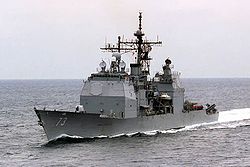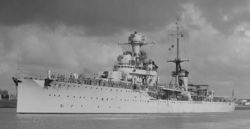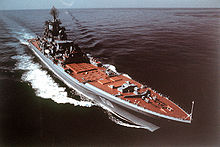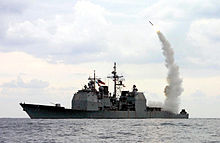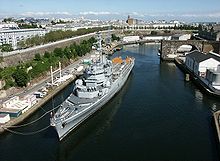- Cruiser
-
For other uses, see Cruiser (disambiguation).
A cruiser is a type of warship. The term has been in use for several hundreds of years, and has had different meanings throughout this period. During the Age of Sail, the term cruiser reflected a type of mission – independent scouting, raiding or commerce protection – fulfilled by a frigate or sloop, which were the cruising warships of a fleet.
From the middle of the 19th century, cruiser came to be a classification for the ships intended for this kind of role, though cruisers came in a wide variety of sizes, from the small protected cruiser to armoured cruisers which were as large (though not as powerful) as a battleship.
By the early 20th century, cruisers could be placed on a consistent scale of warship size, smaller than a battleship but larger than a destroyer. In 1922, the Washington Naval Treaty placed a formal limit on cruisers, which were defined as warships of up to 10,000 tons displacement carrying guns no larger than 8 inches in calibre. These limits shaped cruisers up until the end of World War II. The very large battlecruisers of the World War I era were now classified, along with battleships, as capital ships.
In the later 20th century, the obsolescence of the battleship left the cruiser as the largest and most powerful surface combatant. The role of the cruiser varied according to ship and navy, often including air defence, commerce raiding and shore bombardment. The U.S. Navy in the Cold War period built guided-missile cruisers primarily designed to provide air defence, while the navy of the USSR built cruisers with heavy anti-ship missiles designed to sink NATO carrier task forces.
Currently only three nations, the United States, Russia, and Peru (BAP Almirante Grau (CLM-81) while still in service with the Peruvian Navy), operate cruisers, though the line between cruisers and destroyers is once again blurred. New models of destroyers (for instance the Zumwalt class or Arleigh Burke class) are often larger and more powerful than cruiser classes they replace.
Contents
Early history
The term "cruiser" or "cruizer"[1] was first commonly used in the 17th century to refer to an independent warship. "Cruiser" meant the purpose or mission of a ship, rather than a category of vessel. However, the term was nonetheless used to mean a smaller, faster warship suitable for such a role. In the 17th century, the ship of the line was generally too large, inflexible, and expensive to be dispatched on long-range missions (for instance, to the Americas), and too strategically important to be put at risk of fouling and foundering by continual patrol duties.
The Dutch navy was noted for its cruisers in the 17th century, while the Royal Navy—and later French and Spanish navies—subsequently caught up in terms of their numbers and deployment. The British Cruiser and Convoy Acts were an attempt by mercantile interests in Parliament to focus the Navy on commerce defence and raiding with cruisers, rather than the more scarce and expensive ships of the line.[2] During the 18th century the frigate became the preeminent type of cruiser. A frigate was a small, fast, long range, lightly armed (single gun-deck) ship used for scouting, carrying dispatches, and disrupting enemy trade. The other principal type of cruiser was the sloop, but many other miscellaneous types of ship were used as well.
Steam cruisers
During the 19th century, fleets began to use steam power for their navies. The 1840s saw the construction of experimental steam-powered frigates and sloops. By the middle of the 1850s, the British and U.S. Navies were both building steam frigates with very long hulls and a heavy gun armament, for instance USS Merrimack or HMS Mersey.[3]
The 1860s saw the introduction of the ironclad. The first ironclads were frigates, in the sense of having one gun deck; however, they were also clearly the most powerful ships in the navy, and were principally to serve in the line of battle. In spite of their great speed, they would have been wasted in a cruising role.[4]
The French constructed a number of smaller ironclads for overseas cruising duties, starting with the armored cruisers, a type of ironclad specifically for the traditional cruiser missions of fast, independent, raiding and patrol.
The first true armored cruiser was the Russian General-Admiral, completed in 1874, and followed by the British Shannon a few years later.
Until the 1890s armored cruisers were still built with masts for a full sailing rig, to enable them to operate far from friendly coaling stations.[5]
Unarmored cruising warships, built out of wood, iron, steel or a combination of those materials, remained popular until towards the end of the 19th century. The ironclad's armor often meant that they were limited to short range under steam, and many ironclads were unsuited to long-range missions or for work in distant colonies. The unarmored cruiser - often a screw sloop or screw frigate - could continue in this role. Even though mid- or late-19th century cruisers typically carried up-to-date guns firing explosive shells, they were unable to face ironclads in combat. This was evidenced by the clash between HMS Shah, a modern British cruiser, and the Peruvian monitor Huáscar. Even though the Peruvian vessel was obsolescent by the time of the encounter, it stood up well to roughly 50 hits from British shells.
Steel cruisers
Main article: Protected cruiser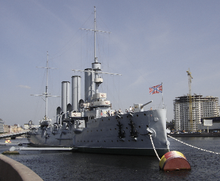 The Russian protected cruiser Aurora
The Russian protected cruiser Aurora
In the 1880s naval architects began to use steel as a material for construction and armament. A steel cruiser could be lighter and faster than one built of iron or wood. The Jeune Ecole school of naval doctrine suggested that a fleet of fast unprotected steel cruisers were ideal for commerce raiding, while the torpedo boat would be able to destroy an enemy battleship fleet.
Steel also offered the cruiser a way of acquiring the protection needed to survive in combat. Steel armor was considerably stronger, for the same weight, than iron. By putting a relatively thin layer of steel armor above the vital parts of the ship, and by placing the coal bunkers where they might stop shellfire, a useful degree of protection could be achieved without slowing the ship too much.
The first protected cruiser was the Chilean ship Esmeralda. Produced by a shipyard at Elswick, in Britain, owned by Armstrong, she inspired a group of protected cruisers produced in the same yard and known as the "Elswick cruisers". Her forecastle, poop deck and the wooden board deck had been removed, replaced with an armored deck.
Esmeralda's armament consisted of fore and aft 10-inch (25.4 cm) guns and 6-inch (15.2 cm) guns in the midships positions. It could reach a speed of 18 knots (33 km/h), and was propelled by steam alone. It also had a displacement of less than 3,000 tons. During the two following decades, this cruiser type came to be the inspiration for combining heavy artillery, high speed and low displacement.
Pre-dreadnought armored cruisers
Steel also had an impact on the construction and role of armored cruisers. Steel meant that new designs of battleship, later known as pre-dreadnought battleships, would be able to combine firepower and armor with better endurance and speed than ever before. The armored cruisers of the 1890s greatly resembled the battleships of the day; they tended to carry slightly smaller main armament (9.2-inch (230 mm) rather than 12-inch) and have somewhat thinner armor in exchange for a faster speed (perhaps 21 knots (39 km/h) rather than 18). Because of their similarity, the lines between battleships and armored cruisers became blurred.
Cruisers from 1900 to 1914
Shortly after the turn of the 20th century there were difficult questions about the design of future cruisers. Modern armored cruisers, almost as powerful as battleships, were also fast enough to outrun older protected and unarmored cruisers. In the Royal Navy, Jackie Fisher cut back hugely on older vessels, including many cruisers of different sorts, calling them 'a miser's hoard of useless junk' that any modern cruiser would sweep from the seas.
Battlecruisers
Main article: Battlecruiser HMS Repulse in 1919.
HMS Repulse in 1919.
The growing size and power of the armored cruiser resulted in the battlecruiser, with an armament and size similar to the revolutionary new dreadnought battleship, was the brainchild of British admiral Jackie Fisher. He believed that to ensure British naval dominance in its overseas colonial possessions, a fleet of large, fast, powerfully-armed vessels which would be able to hunt down and mop up enemy cruisers and armored cruisers with overwhelming fire superiority was needed. These vessels came to be known as the battlecruiser, and the first were commissioned into the Royal Navy in 1907. Germany and eventually Japan followed suit to build these vessels, replacing armored cruisers in most front line roles.
Light cruisers
 HMS Caroline, a World War I era light cruiser, still serves as a headquarters and training vessel in Belfast.
HMS Caroline, a World War I era light cruiser, still serves as a headquarters and training vessel in Belfast. Main article: Light cruiser
Main article: Light cruiserAt around the same time as the battlecruiser was developed, the distinction between the armored and the unarmored cruiser finally disappeared. By the British Town-class cruiser (1910), it was possible for a small, fast cruiser to carry both belt and deck armor, particularly when turbine engines were adopted. These 'light armored cruisers' began to occupy the traditional cruiser role once it became clear that the battlecruiser squadrons were required to operate with the battle fleet.
Flotilla leaders
Main article: Flotilla leaderSome light cruisers were built specifically to act as the leaders of flotillas of destroyers.
Auxiliary cruisers
Main article: Auxiliary cruiserThe auxiliary cruiser was a merchant ship hastily armed with small guns on the outbreak of war. Auxiliary cruisers were used to fill gaps in their long-range lines or provide escort for other cargo ships, although they generally proved to be useless in this role because of their low speed, feeble firepower and lack of armor. In both world wars the Germans also used small merchant ships armed with cruiser guns to surprise Allied merchant ships.
Some large liners were armed in the same way. In British service these were known as Armed Merchant Cruisers (AMC). The Germans and French used them in World War I as raiders because of their high speed (around 30 knots (56 km/h)), and they were used again as raiders in World War II by the Germans and Japanese. In both the First World War and in the early part of the Second, they were used as convoy escorts by the British.
World War I
Main article: Naval warfare of World War ICruisers were one of the workhorse types of ship of World War I.
Cruisers from 1919-1945
Naval construction in the 1920s and 1930s was limited by international treaties designed to prevent the repetition of the Dreadnought arms race of the early 20th century. The Washington Naval Treaty of 1922 placed limits on the construction of ships with a displacement of 10,000 tons or more and an armament of greater than 8-inch (200 mm) calibre. A number of navies commissioned classes of cruisers at the top end of this limit.
The London Naval Treaty in 1930 then formalised the distinction between these 'heavy' cruisers and light cruisers: a 'heavy' cruiser was one with guns of 6.1-inch (150 mm) calibre or more. The Second London Naval Treaty attempted to reduce the tonnage of new cruisers to 8,000 or less, but this had little impact; Japan and Germany were not signatories, and navies had already begun to evade treaty limitations on warships.
Heavy cruisers
See also: Heavy cruisersThe heavy cruiser was a type of cruiser, a naval warship designed for long range, high speed and an armament of naval guns roughly 8-inch (200 mm) in calibre. The first heavy cruisers were built in 1915, although it only became a widespread classification following the London Naval Treaty in 1930. The heavy cruiser's immediate precursors were the light cruiser designs of the 1910s and 1920s; the US 8-inch 'treaty cruisers' of the 1920s were originally classed as light cruisers until the London Treaty forced their redesignation. Heavy cruisers continued in use until after World War II.
The German pocket battleships
The German Deutschland-class was a series of three Panzerschiffe ("armored ships"), a form of heavily armed cruiser, built by the German Reichsmarine in accordance with restrictions imposed by the Treaty of Versailles. The class is named after the first ship of this class to be completed (the Deutschland). All three ships were launched between 1931 and 1934, and served with Germany's Kriegsmarine during World War II.
The British began referring to the vessels as pocket battleships, in reference to the heavy firepower contained in the relatively small vessels; they were considerably smaller than battleships and battlecruisers, and although their displacement was that of a heavy cruiser, they were armed with guns larger than the heavy cruisers of other nations. Deutschland-class ships continue to be called pocket battleships in some circles. The ships were actually two feet longer than the American Pennsylvania-class - although the latter was unusually stubby for a modern battleship.
Deutschland-class ships were initially classified as Panzerschiffe, but the Kriegsmarine reclassified them as heavy cruisers in February 1940.
Anti-aircraft cruisers
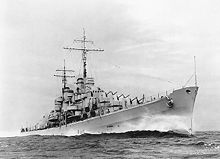 USS Atlanta (CL-51)
USS Atlanta (CL-51)
The development of the anti-aircraft cruiser began in 1935 when the Royal Navy re-armed HMS Coventry and HMS Curlew. Torpedo tubes and 6-inch (15 cm) low-angle guns were removed from these World War I light cruisers and replaced by ten 4-inch (10 cm) high-angle guns with appropriate fire-control equipment to provide larger warships with protection against high-altitude bombers.[6]
A tactical shortcoming was recognized after completing six additional conversions of C-class cruisers. Having sacrificed anti-ship weapons for anti-aircraft armament, the converted anti-aircraft cruisers might need protection themselves against surface units. New construction was undertaken to create cruisers of similar speed and displacement with dual-purpose guns.
Dual-purpose guns offered good anti-aircraft protection with anti-surface capability for the traditional light cruiser role of defending capital ships from destroyers. The first purpose built anti-aircraft cruiser was the British Dido-class, completed shortly before the beginning of World War II. The US Navy Atlanta-class anti-aircraft cruisers (CLAA) were designed to match capabilities of the Royal Navy. Both Dido and Atlanta carried torpedo tubes.
The quick-firing dual-purpose gun anti-aircraft cruiser concept was embraced in several designs completed too late to see combat including USS Worcester (CL-144) and USS Roanoke (CL-145) completed in 1948 and 1949, two De Zeven Provinciën-class cruisers completed in 1953, De Grasse and Colbert completed in 1955 and 1959, and HMS Tiger, HMS Lion and HMS Blake completed between 1959 and 1961.[7]
Most post–World War II cruisers were tasked with air defense roles. In the early 1950s, advances in aviation technology forced the move from anti-aircraft artillery to anti-aircraft missiles. Therefore most cruisers of today are equipped with surface-to-air missiles as their main armament. The modern equivalent of the anti-aircraft cruiser is the guided missile cruiser (CAG/CLG/CG/CGN).
Later 20th century
The rise of air power during World War II dramatically changed the nature of naval combat. Even the fastest cruisers could not steer quickly enough to evade aerial attack, and aircraft now had torpedoes, allowing moderate-range standoff capabilities. This change led to the end of independent operations by single ships or very small task groups, and for the second half of the 20th century naval operations were based on very large fleets able to fend off all but the largest air attacks.
This has led most navies to change to fleets designed around ships dedicated to a single role, anti-submarine or anti-aircraft typically, and the large "generalist" ship has disappeared from most forces. The United States Navy, the Russian Navy, and the Peruvian Navy are the only remaining navies which operate cruisers.Italy used Vittorio Veneto until 2003, France operated a single cruiser until May 2010: Jeanne d'Arc, which in the NATO pennant number system was classified as an aircraft carrier, but for training purposes only.
In the Soviet Navy, cruisers formed the basis of combat groups. In the immediate post-war era they built a fleet of large-gun ships, but replaced these fairly quickly with very large ships carrying huge numbers of guided missiles and anti aircraft missiles. The most recent ships of this type, the four Kirovs, were built in the 1970s and 1980s. Currently two of the Kirov classes are currently in refit until 2020, and one is in refit until 2012. Only the Pyotr Velikiy is in active service. Russia also operates one Kara-class and four Slava-class cruisers, plus one Kuznetsov-class carrier which is officially designated as a cruiser.
Currently, the Kirov class of heavy missile cruisers are used for command purposes, as the Pyotr Velikiy is the Flagship of the Northern Fleet. However, their air defense capabilities are still powerful, as shown by its array of Point defense missiles, from 44 OSA-MA missiles to 196 9K311 Tor missiles. For longer range targets, the S-300 is used. For closer range targets, AK-630 or Kashtan CIWSs are used. Asides from that, Kirovs have 20 P-700 Granit for anti-ship warfare. For target acquisition beyond the radar horizon, three helicopters can be used. Besides a vast array of armaments, Kirov classes are also outfitted with many sensors and communications equipment, allowing them to lead the fleet.
The United States Navy has centered on the aircraft carrier since World War II. The Ticonderoga-class cruisers, built in the 1980s, were originally designed and designated as a class of destroyer, intended to provide a very powerful air-defense in these carrier-centered fleets. The ships were later redesignated largely as a public relations move, in order to highlight the capability of the Aegis combat system the ships were designed around.[citation needed]
In the years since the launch of Ticonderoga in 1981 the class has received a number of upgrades that have dramatically improved their capabilities for anti-submarine and land attack (using the Tomahawk missile). Like their Soviet counterparts, the modern Ticonderogas can also be used as the basis for an entire battle group. Their cruiser designation was almost certainly deserved when first built, as their sensors and combat management systems enable them to act as 'flagships' for a surface warship flotilla if no carrier is present, but newer ships rated as destroyers and also equipped with AEGIS approach them very closely in capability, and once more blur the line between the two classes.
Aircraft cruisers
Main article: Aircraft cruiserFrom time to time, some navies have experimented with aircraft-carrying cruisers. One example is the Swedish HMS Gotland. Another variant is the helicopter cruiser. The last example in service was the Soviet Navy's Kiev-class, the last unit of which has been converted to a pure aircraft carrier and sold to India. The Russian Navy's Kuznetsov is nominally designated as an aviation cruiser but otherwise resembles a standard medium aircraft carrier, albeit with an SSM battery. The Royal Navy's aircraft-carrying Invincible-class and the Italian Navy's aircraft-carrying Giuseppe Garibaldi vessels were originally designated 'through-deck cruisers', but have since been designated as small aircraft carriers.
Cruisers in service today
Few cruisers remain operational in the world navies. Those that do are:
- United States Navy: 22[8] Ticonderoga-class guided missile cruisers.
- Russian Navy: One Kirov-class large missile cruiser (sometimes referred to as battlecruisers due to their size) and three Slava-class missile cruisers and one Kara-class.
- Peruvian Navy: The BAP Almirante Grau (CLM-81), a De Zeven Provinciën-class cruiser, was modernized as a guided-missile cruiser in the late eighties, is the world's last operational gun cruiser.
Main article: United States Navy 1975 ship reclassificationPrior to the introduction of the Ticonderogas, the US Navy used odd naming conventions that left its fleet seemingly without many cruisers, although a number of their ships were cruisers in all but name. From the 1950s to the 1970s, US Navy "cruisers" were large vessels equipped with heavy offensive missiles (including the Regulus nuclear cruise missile) for wide-ranging combat against land-based and sea-based targets. All save one—USS Long Beach (CGN-9)—were converted from World War II Chicago-, Baltimore- and Cleveland-class cruisers.
"Frigates" under this scheme were almost as large as the cruisers and optimized for anti-aircraft warfare, although they were capable anti-surface warfare combatants as well. In the late 1960s, the US government perceived a "cruiser gap"—at the time, the US Navy possessed six ships designated as "cruisers", compared to 19 for the Soviet Union, even though the USN possessed at the time 21 "frigates" with equal or superior capabilities to the Soviet cruisers—because of this, in 1975 the Navy performed a massive redesignation of its forces:
- CVA/CVAN were redesignated CV/CVN (although USS Midway (CV-41) and USS Coral Sea (CV-43) never embarked anti-submarine squadrons).
- DLG/DLGN (Frigate/Nuclear-powered Frigate) were redesignated CG/CGN (Guided Missile Cruiser/Nuclear-powered Guided Missile Cruiser).
- Farragut-class guided missile frigates (DLG), being smaller and less capable than the others, were redesignated to DDGs (USS Coontz was the first ship of this class to be re-numbered; because of this the class is sometimes called the Coontz-class);
- DE/DEG (Ocean Escort/Guided Missile Ocean Escort) were redesignated to FF/FFG (Guided Missile Frigates), bringing the US "Frigate" designation into line with the rest of the world.
Also, a series of Patrol Frigates of the Oliver Hazard Perry-class, originally designated PFG, were redesignated into the FFG line. The cruiser-destroyer-frigate realignment and the deletion of the Ocean Escort type brought the US Navy's ship designations into line with the rest of the world's, eliminating confusion with foreign navies. In 1980, the Navy's then-building DDG-47 class destroyers were redesignated as cruisers (CG-47 Ticonderoga-class guided missile cruiser) to emphasize the additional capability provided by the ships' Aegis combat systems.
See also
References
- ^ The alternative spelling could be found at least as late as 1900: Jackie Fisher wrote "We a require an increase.... in all classes of cruizer" in a letter dated 20th Feb 1900. Mackay, R. Fisher of Kilverstone, p.242
- ^ Rodger, N. A. M.: The Command of the Ocean, A Naval History of Britain 1649–1815. Allen Lane, London, 2004. ISBN 0-7139-9411-8
- ^ Parkes, p.8
- ^ Parkes, p.17
- ^ Hill, Richard: War at Sea in the Ironclad Age. Cassell, London, 2000. ISBN 0-304-35273-X
- ^ Friedman, Norman "Anti-Aircraft Cruisers: The Life of a Class" United States Naval Institute Proceedings January 1965 p.86
- ^ Friedman, Norman "Anti-Aircraft Cruisers: The Life of a Class" United States Naval Institute Proceedings January 1965 pp.96-97
- ^ Naval Vessel Register
Sources
- Parkes, Oscar British Battleships (2nd Edition). Leo Cooper, London, 1990. ISBN 0-85052-6043
External links
- Philip Sims, Michael Bosworth, Chris Cable, Howard Fireman. "Historical Review of Cruiser Characteristics, Roles and Missions". SFAC Report Number 9030-04-C1. Future Concepts and Surface Ship Design Group, Naval Sea Systems Command, United States Navy. http://www.aandc.org/research/cruisers/cr_navsea.html. Retrieved March 25, 2011.
Categories:- Cruisers
- Ship types
Wikimedia Foundation. 2010.

